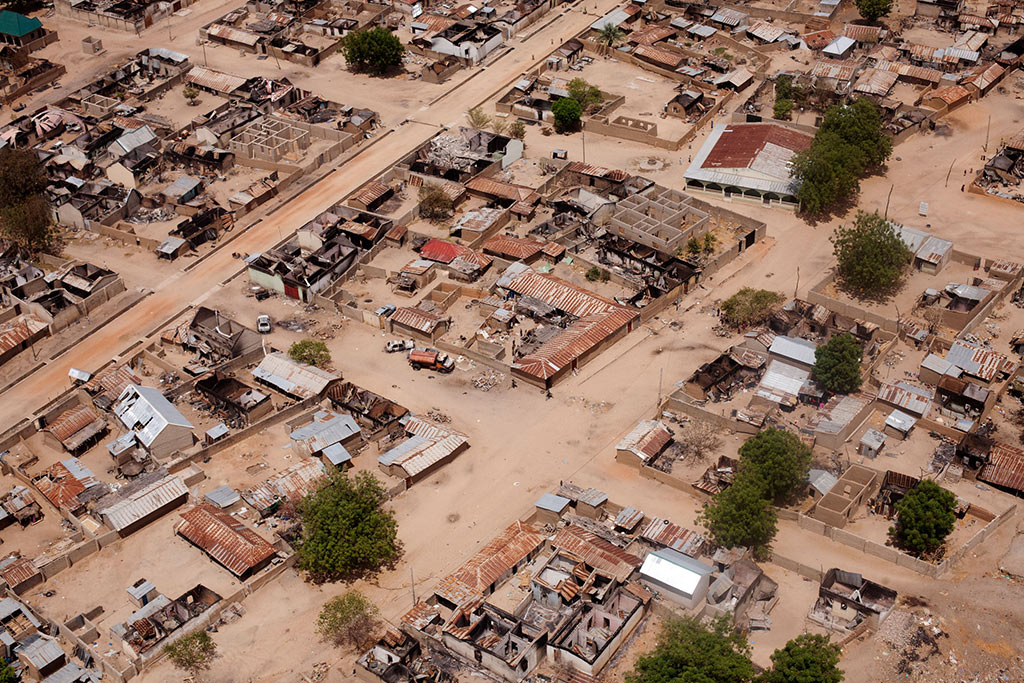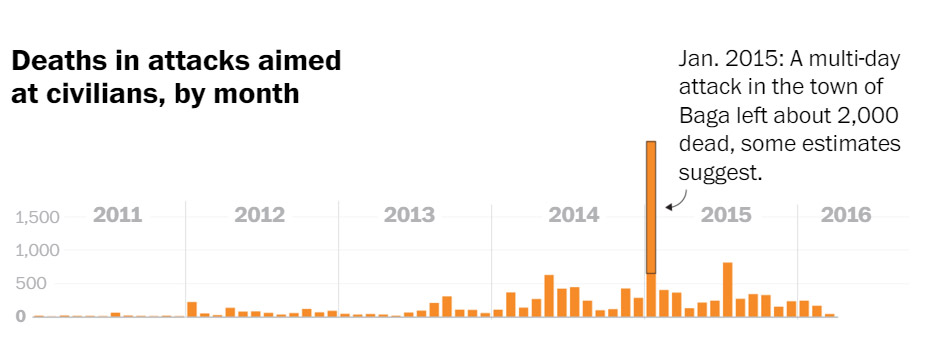The brutal toll of Boko Haram’s attacks on civilians
As the Islamic State’s attacks in Europe have captured the world’s attention, an ISIS-affiliated group has been waging an even deadlier campaign in Africa.
Hundreds killed when 20 attackers detonated coordinated blasts at police stations around a city. Fifty dead when suicide bombers, including women and children, attacked a market and camps housing people trying to escape the violence. Fifty Christians targeted and killed in a student housing area near a school.
These are a few of the hundreds of horrors wrought regularly by Boko Haram, an Islamist militant organization based in Nigeria, over the past six years.
[It’s not just the Islamic State. Other terror groups surge in West Africa.]
The group’s rise, some experts say, is attributable to government corruption and economic differences between the Muslim northern areas and more populous and prosperous Christian South.
While military forces have had some success regaining territory in the past year, Boko Haram continues to carry out attacks on civilians.

People gather around burnt cars near a Catholic church after a bomb blast in Nigeria’s capital, Abuja, on December 25, 2011. (Sunday Aghaeze/Getty Images)
Last year was the group’s deadliest yet, according to the Armed Conflict Location and Event Data Project, which tracks civil unrest and political violence in Africa and Asia.

Young girls fleeing Boko Haram walk past livestock burned by the militants on Feb. 6 in Mairi village, near Maiduguri. (AFP/Getty Images)
Researchers recorded more than 6,000 fatalities resulting from Boko Haram attacks aimed at civilians. Because the counts below include only attacks on civilians, and not battles over territory, they underestimate what some say is a total of 15,000 people killed by the group.
[Did Boko Haram attack leave 150 dead — or 2,000? Satellite imagery sheds new light.]
Conflict in Nigeria, Africa’s most populous country, has spilled over into neighboring nations, including Cameroon, which recently launched a campaign to retake territory from the militants. Chad, Benin and Niger have also contributed soldiers to the fight.
[Cameroon seeks to drive out Boko Haram ‘once and for all’]
How Boko Haram evolved
A government crackdown in 2009 led the group to turn to violence. In 2010, a jailbreak freed more than 700 inmates. Increasingly in the following years, militants carried out hundreds of attacks, many that killed more than 10, and some that claimed hundreds.
As government forces have reclaimed territory, the group’s scorched-earth tactics have been on display.
“The scene was post-apocalyptic, an entire city destroyed. Almost every building, it seemed, had been ransacked or set on fire,” Washington Post reporter Kevin Sieff wrote last year after touring the group’s former capital city, Gwoza. “Schools were in ruin. Bodies decayed in a pile.”
[I’ve seen the Taliban’s brutality in Afghanistan. Boko Haram might be worse.]

An aerial view of the destroyed town of Gwoza, Boko Haram’s base in northern Nigeria, recently retaken by the Nigerians, on April 8, 2015. (Jane Hahn for the Washington Post)
Millions of Nigerians fleeing violence
Stopping the insurgency is not the only crisis Nigeria faces. More than 2 million Nigerians have been forced to leave their homes to escape the violence. The map below shows the number of internally displaced persons by country, as reported by the Internal Displacement Monitoring Center:
* Recent estimate from the International Organization for Migration

A girl does laundry in the Dalori camp for internally displaced persons in Maiduguri, Nigeria, which houses close to 20,000 people. (Jane Hahn for the Washington Post)
[They were freed from Boko Haram’s rape camps. But their nightmare isn’t over.]
While it may not draw the attention of the West as frequently as the Islamic State, Boko Haram is one of the most devastating terrorist organizations in the world. Regaining territory from the group will only be the first step in a long process of healing the deep wounds it has inflicted.
(Washington Post – Sources: Armed Conflict Location and Event Data Project, Congressional Research Service, Internal Displacement Monitoring Center, Council on Foreign Relations, staff reports.)
Source: April 3, 2016 (Washington Post)






















